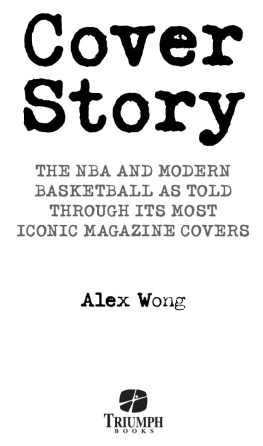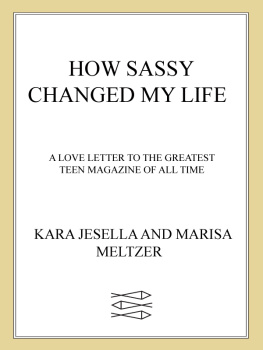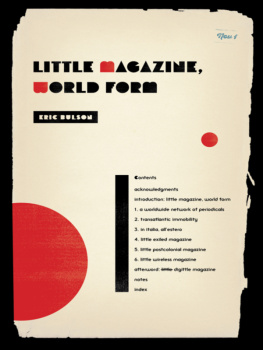For Nick, Florine, Eden and Pierre.
My heartfelt thanks must go to Janet Floyd for her constant support, encouragement and insightful comments at all stages in the development of this book. Without her enthusiasm, advice and much-valued friendship, little would have been achieved. I am also grateful to Sue Harper for her very helpful input at the early stages of this project, and for kindly introducing me to Jean Orba. on Houseparty owes a huge debt to Jean Orba, who generously granted a very long interview and also provided further responses at later stages. As always, I remain truly grateful for the love and support I receive from Nick, Florine, Eden and Pierre, and I dedicate this book to them.
A research grant from Portsmouth University CCI Faculty very helpfully enabled some teaching relief and gave financial assistance towards travel to archives to unearth the primary material at the heart of the book. I would like to thank my colleagues at Portsmouth University for their support and the students at Portsmouth University for their comments and observations.
Very helpful feedback has been received as a result of papers given at conferences, seminars and public lectures, including British Culture and Society in the 1970s, University of Portsmouth, July 2008; Blowing the Cover: Sex and Gender in Magazines, The Womens Library, March 2009; Designing the Decades: The 1970s, Victoria and Albert Museum, February 2012; Women in Media, Queens University, Belfast, March 2012; Women in Magazines, Kingston University, June 2012; Television for Women, University of Warwick, May 2013; One World Forum: Feminism Panel, University of Warwick, January 2014; History Seminar on 1970s Feminism, Southampton University, February 2014; Situating Womens Liberation: Historicizing a Movement, University of Portsmouth, July 2014.
The dependence upon a good deal of primary material in Magazine Movements has led to research in numerous archives and libraries, where I have been greatly assisted by archivists and librarians who have often gone out of their way to locate and even suggest materials. I have encountered a number of commercial organisations who have also been very helpful and interested in this project. I am very grateful for the kind permission granted by IPC media to reproduce images from Housewife magazine, assisted by David Abbott. The British Film Institute archives were the source of much background information for the Houseparty chapter, and I am indebted to Nathalie Morris and Jonny Davies at the BFI National Archive, Berkhamsted, for permitting an early viewing of letters from the Southern Television Written Archives. The Wessex Film and Sound Archive, Winchester, kindly granted me access to archived Houseparty footage and, with Heather Needhams help, arranged permission to reproduce images from the programme. I am most grateful to the Wessex Film and Sound Archive for this permission. I would also like to thank Ed Thomas, technical assistant, who produced the images for the Houseparty chapter.
All staff at the Womens Library Glasgow, perhaps the friendliest archive in the world, including Wendy Kirk and Gabrielle MacBeth, must be thanked for all their help with information and materials for the Arena Three chapter. I would also like to thank Maureen Duffy for her advice and interest in the Arena Three images and chapter. Martin Gibbs of News Syndication, News UK, kindly supplied the News of the World image and I am grateful to News of the World/News Syndication for permission to reproduce this image. I remain indebted to the very well-informed staff at the Womens Library, London, now housed at the LSE, for their general assistance and in particular for first bringing Mukti to my attention.
I would like to express my thanks to all the staff at the Mass Observation Archive, The Keep, Sussex, for their assistance in working through the Rose Hacker Small Collection folders and other sections of the archive. Karen Watson and Rose Lock of the MOA were particularly helpful regarding the illustrations, and Jenny Geering produced the fine images for on feminist magazines. I was greatly assisted by Polly Russell of the British Library in gaining permission from the collective. I would also like to thank the Fawcett Society for their kind permission to reproduce the Paget illustration, with help from Miranda Seymour-Smith.
Assistance has been received from archivists and librarians at the London School of Economics Hall-Carpenter Archive, Sussex University Library and the British Library Sound Archive all of whom have helped in the development of this book. The staff at the British Library must also be thanked for the consistent and reliable work they perform. Jovita Callueng, Jackie Brown and Anna Vernon were all extremely helpful in securing and facilitating the images for Magazine Movements. Greta Friggens, University of Portsmouth Library, dealt helpfully and patiently with all my late Friday afternoon requests, and Justin Vaughan demonstrated tremendous technical skill in enhancing fragile 1970s televisual images, ensuring their inclusion. I am pleased to also thank Katie Gallof and Mary Al-Sayed of Bloomsbury Academic for their support in bringing this book to publication.
Every effort has been made to trace copyright holders and to obtain their permission for use of copyright material. The publisher apologises for any errors or omissions in the above list and would be grateful if notified of any corrections that should be incorporated in future reprints of editions of this book.
Magazines are rich texts to study: of variable presentation and layered meaning, with multiple authorship and elusive target audience, they present endless challenges of interpretation and critique. However, their influence, authority, popularity and cultural competence make them significant objects of critical enquiry, be they print periodicals or broadcast programmes. A magazine can offer a whole world to its readers in terms of outlook and instruction, apparently embracing every aspect of life, nurturing body and mind, teaching lifestyle, encouraging success at home, in the workplace and in all manner of relationships, and so seemingly leading the way to a more fulfilled existence. Magazines are perhaps the ultimate zeitgeist media form. It is precisely this expansive authority, dealing in the detail of lives that draws both readers and critics. Any media form that purports to guide its target audience to a better version of themselves, through direct and intimate communication styles, is a media form with a political agenda. The political intention may be overtly stated or latently enfolded between the lines of articles and advertisements. It may be the impetus of capitalism in the pursuit of profit and corporate competition or it may be gender politics or an anti-hegemonic stance that provides the imperative. The magazine form lends itself to opinionated expression.
Magazines are rich texts, but they are also hugely diverse and intricately complex. Their varied content opens up numerous avenues for critical investigation, and their real and imagined target audiences lead to a considerable range of cultural and social modes of understanding. Consequently meaning, reception and cultural competence can remain fascinating, but elusive. Further analysis, it seems, is always possible of magazines. Their depth in years, volumes, issues or programmes, their breadth across a vast array of subjects and their interconnectedness through publishing house and associated industries such as advertising, present rather daunting objects of study. Not only do some magazines last for decades, but studying their reach can be extensive work, encompassing changes in society, reflecting diverse engagements with issues of gender and class, exposing industrial processes and functions, showcasing the talents of writers and editors and demonstrating a remarkable cultural embeddedness. Meaning and communication, meanwhile, are conveyed variably and often unknowably between writer and reader, and there are endless permutations in the format, content, tone and appearance of magazines. Moreover, the very term magazine has lent itself to multiple interpretations and uses and is used to indicate any media genre with mixed content: a television programme, radio broadcast, web page, newspaper supplement, even a home-made scrapbook might call itself a magazine. The term is a capacious one.







